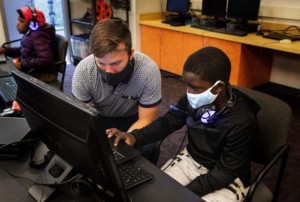Innovation Happens at the School House

“We believe there’s untapped innovation in our schools,” says Kenneth Zeff, Chief Strategy and Innovation at Fulton County Schools in Atlanta, Georgia. “The central office is not in charge of innovation; innovation happens at the school house. The role of our office is not to create innovation but create an environment that fosters innovation. We have 14,000 employees and believe they’re engines of innovation.”
As schools come online as part of the charter system, each first develops a three-year strategic plan, and asks ‘what problem are we trying to solve?’ There’s a six month planning process, where the school defines ‘this is what we want to be’, and ‘this law or policy is in the way’. “We say start with who you want to be, and also figure out who you’re not,” says Zeff. At the end of development of the strategic plan there is a process to seek waivers. The first twenty schools made the transition to the charter system during the 2012-2013 school year. During the 2013-14 school year, 37 more schools begin charter system implementation, then the final 40 schools transition the next year.
The planning process includes getting to know the school and its community from all angles. “Innovation only happens when you’re clear about what problems you’re trying to solve,” says Zeff. “First each school does an environmental scan of their school’s community. They review demographics … any shift? Are parents active, are private schools nearby, any gangs, any economic issues in the community? Are there strong churches or synagogues and support networks? Then they conduct an organizational scan, looking at strengths and weaknesses at the school such as attendance or other academic issues. Sure we might say ‘give everyone an iPad’ or ‘let’s have uniforms’ but if 8th graders are struggling with the concepts of algebra, uniforms are not going to solve it. We have to understand where we are as a school community first.”
Each school in Fulton’s charter system has or will have a School Governance Council, ten elected members from teachers, parents and community, similar to a Board of Directors, who are given ‘authentic control’. “This is not a bake sale,” Zeff explains, “but rather a way to provide parents, school staff, and community members with a leadership role in the management of the school.” After developing a plan, the Council approves a school budget to support the plan. The principal informs the conversation, but doesn’t vote.
There were ninety-five openings for School Governance Council seats with the first charter system cohort group of 20 schools, and 230 candidates ran for seats. “The Governance Councils represent the community; it’s not just the principal making decisions,” says Zeff. “People are looking for opportunities to be part of reform and innovation.” The council members are trained, and meet regularly. They submit plans in November for the following year. The Councils are given lots of information, such as attendance data, test scores, and all kinds of relevant data to inform their work. “We want them to have information and not just about the prom. They have to know about what they’re trying to solve for.” The ten member councils have 2-year staggered terms.
Next the council works on long term objectives, Zeff explains. “For example maybe we have struggling athletes. We identify students needing help, then double block reading and math, and exempt them from PE. We can waive the state law for PE as an innovation. Or maybe we need internships for relevance for a group that desires learning outside the classroom. We can give a waiver but first we must understand what problem we’re trying to solve. Maybe we feel we need deeper content knowledge in a subject matter. A school might hire a physicist to teach physics, and then be able to waive his or her teaching certificate requirement.
“Giving people freedom is not enough in a K-12 system. Teachers and principals have been successful in a compliance environment, so we create some structure to give support and apply pressure when needed. By providing School Governance Councils authentic governing power we’re no longer expecting a hero-principal to come save the school like in Hollywood movies. Creating good governance and culture can’t just fall on the principal. A school needs governance to innovate. The Governance Councils can connect with the school’s community and offer support and insight.”
To further spur innovative ideas at the school level Fulton has created an Innovation Fund from a state allotment of $4 million per year, managed as a philanthropy by the Fulton Education Foundation. A school is able to apply for this internal funding grant supported by their 3-year strategic plan. “Many innovative ideas a school would suggest have costs attached; for example Saturday School would have associated costs for transportation, food and security,” says Zeff. “Money is set aside without a lot of complicated processes. We believe it is a good incentive if an idea can be brought to life with easy-to-access funding.”
Also Fulton received a grant to pair six independent schools in Atlanta with six schools in the charter system. Principals get together to talk and share innovative practices. “We have a clear idea of our problems,” says Zeff, “and this cooperation allows us to see how other schools solve similar problems.”
Fulton’s innovation office has built a Knowledge Management System that tracks innovative practices on its website, with resources based on proven practices. “For example,” says Zeff, “a school rethinking scheduling, looking to maximize instructional minutes in a day, could look that up. The website includes a catalog of practices across country, vetted so they’re more reliable than a Google search, and includes contact information. And we also catalog practices that have been done by our own schools to track results.”
“We’re spending some time building long term support systems,” says Zeff. “We don’t want to move too fast. We don’t want to rush in and buy iPads for everyone, although we did have a successful pilot with them. It’s about building a sustainable system.”





0 Comments
Leave a Comment
Your email address will not be published. All fields are required.